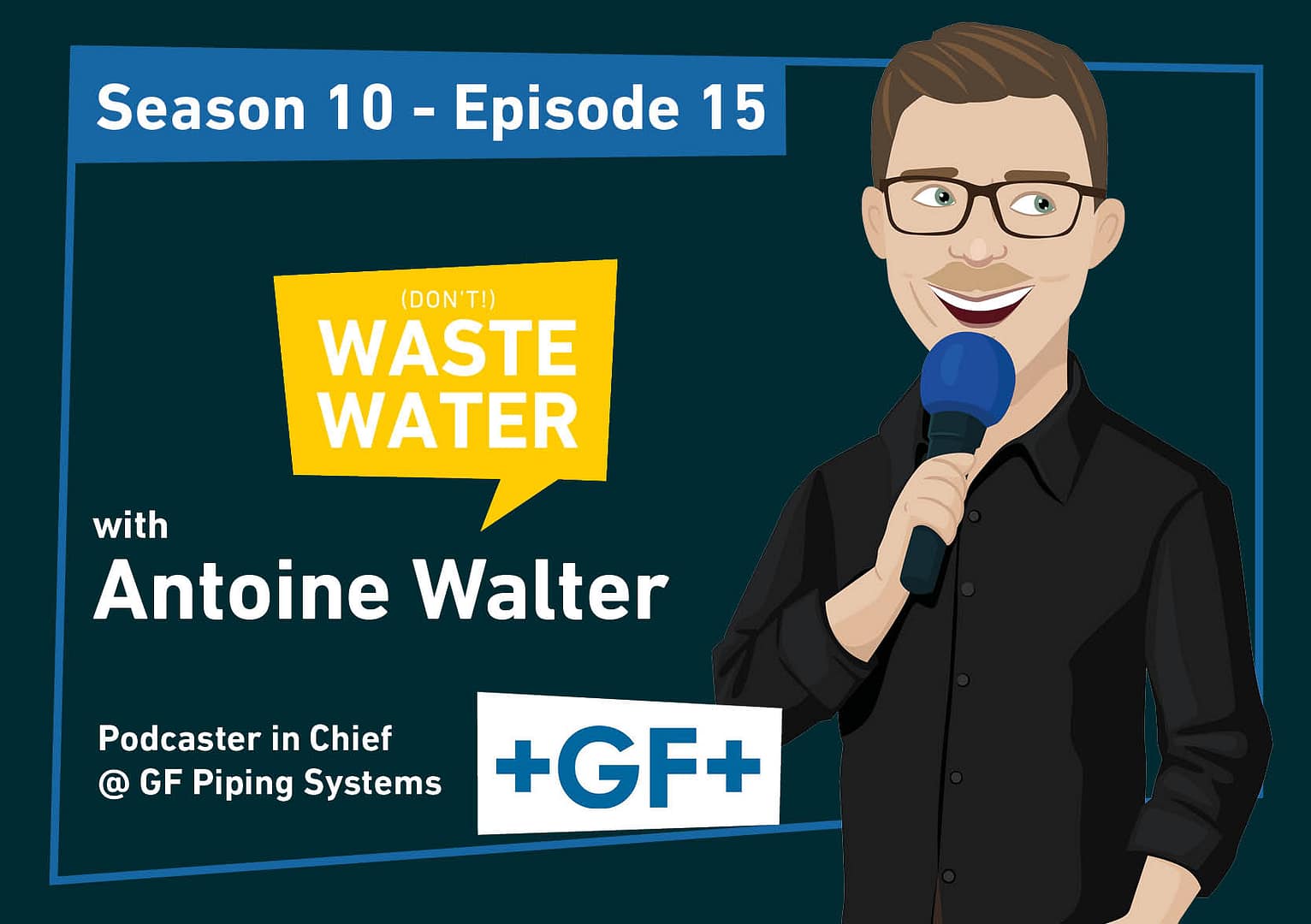Let me write that sentence I hate: water is essential for life. But beyond hydration, what if it also played a crucial role in enhancing public health? That’s the promise of micro-dosed lithium. This trace mineral, we usually associate with mining for the battery supply chain, is now being spotlighted for its potential health benefits when present in tap water.
Research suggests that areas with naturally higher levels of lithium in water might see notable reductions in suicide rates, violent crime, and even Alzheimer’s disease. In other words, it could turn a simple, everyday act of drinking water into a key to not just physical, but also mental well-being.
Let’s explore the evidence and implications of adding micro-dosed lithium to tap water and how it could represent a groundbreaking approach to public health.
with 🎙️ Sudhir Gadh – CEO & Founder @ Third Element Water
Resources:
nb: I’ve directly linked to the research I quote in the article below ⬇️
🔗 Check out Third Element Water’s website
🔗 Go thank Sciens Water for being an awesome partner
🔗 Come say hi to Sudhir on Linkedin

is on Linkedin ➡️
Full Video:
Table of contents
- Resources:
- Full Video:
- The Micro-Dosed Lithium Promise: Too Good to be True?
- How I came across micro-dosed lithium
- A 1989 study from Texas on micro-dosed Lithium
- Why do we refuse the Lithium Miracle Pill?
- The Low Dose Lithium No-Man’s Land
- What does the Regulation say on Drinking Micro-Dosed Lithium Water?
- Two Questions moving forward
- Could we supplement Tap Water with micro-dosed Lithium?
- Micro-Dosed Lithium: My Conclusion
- Bonus: My Conversation with Sudhir Gadh
- What’s the right scale to deploy micro-dosed lithium?
- Emulating Fluoride’s path to market
- How to navigate the regulation no-man’s land?
- What’s Third Element Water’s Business Plan?
- Where does the company stand in its roll out of micro-dosed Lithium?
- Lithium supplements are not new
- What does the timeline to adoption look like?
- Other Episodes:
The Micro-Dosed Lithium Promise: Too Good to be True?
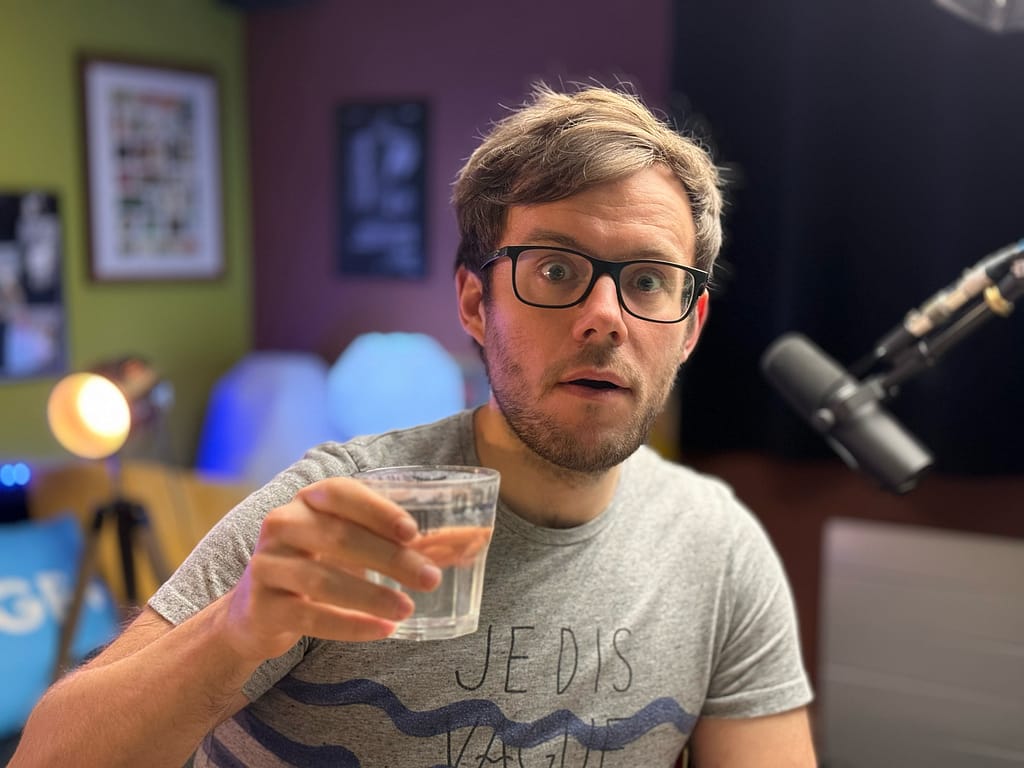
This glass of Water:
- could improve my cardiac function by enhancing my heart’s contractility, offering a protective effect against cardiovascular diseases.
- It could reduce my risks of osteoporosis by contributing to bone formation.
- It could help manage my obesity or type 2 diabetes.
- It could reduce my risk of developing Alzheimer’s disease by promoting neurogenesis.
- It could also have anti-inflammatory effects and antioxidant properties, enhance my cognitive abilities, support my body while it ages, potentially have positive effects in treating Type 1 Diabetes…
- … and have synergistic effects while I exercise!
All of that because of one mineral I just added in my regular tap water: Lithium.
But not just Lithium, Lithium at a certain dose, a micro-dose to be a bit more specific.
Today, we’ll dive deeper into the studies behind my introduction claims, then swiftly look at the history behind Lithium’s ambiguous link with health, check what the regulation says, or rather doesn’t say, and finally look forward to two ways to act upon Lithium’s potential positive health effects.
But before going into the details, I need to give you a bit of context.
How I came across micro-dosed lithium
This topic was kinda dropped on me at the latest Rethinking Water Conference in New York. As part of my partnership with the incredible Sciens Water folks, I’m creating a cozy interview booth, starting the cameras and the microphones, sitting down, and then off we go for about ten hours straight of conversations and interviews.

That’s an incredible feeling, because I can be “in the zone” for an uninterrupted day, chatting with the most brilliant water minds, yet that also has a drawback.
Sometimes, when my guests sit down on the couch, I have no clue about who they are and what they do. There are 1.7 million water professionals in the US alone; I’m not proud, but I can’t pretend I know them all. Maybe more problematic, they sometimes come to discuss a topic I never heard of.
I need to research my topics before telling you about it!
And that matters a lot because I owe you to raise the right questions and steer the conversation towards the best possible insights, but also ensure I don’t give you wrong information or get too strongly on board of a well-crafted sales pitch.
To give you a sense of what I mean here, the closest example to today’s topic is when I interviewed Gerald Pollack. I knew little about the physics of the fourth phase of Water, but I had read his book and research papers, taken loads of notes, and could enter the interview prepared. These are always unscripted and are genuine conversations, but trust me, I prepare them intensively.
So, that day, I had just finished discussing public acceptance of water reuse with Austin Alexander, a topic I know pretty well, when Sudhir Gadh sat down on the couch to give me this elevator pitch:
Third Element Water’s Elevator Pitch
My name is Sudhir Gadh. I’m a doctor. I’m a psychiatrist here in New York.
My company is called Third Element Water. We have found a wonderful source of lithiated Water in West Texas and bottled it. But instead of just selling that Water I’m raising awareness about, not just the quality and the amount of Water around the World, but content. The minerals. What are those total dissolved solids? And what is the best solid in there? It’s actually Lithium.
I know the lithium topic pretty well, but on the mining side of the story, as a vector of the EV revolution, not as a health topic. So from there on, I navigated by sight.
In the next three minutes, Sudhir taught me that:
The bold health claims of micro-dosed lithium
That’s a lot of claims, and still just some of them, you can find the full interview on my podcast channel – and I’d recommend it because Sudhir is a great speaker and a very kind and affable person.
But when I’m having this kind of conversation, I can’t just trim out my stumbles and publish it; I really believe I owe you to dive deeper or not publish it at all.
There’s snake oil outside, and I don’t want to be the one to advertise it.
Hence, this question to Sudhir:
Antoine: You mentioned your studies on the positive health effects. Is it something you can openly share?
Sudhir: Of course!
And in fact, if you go to Third Element’s website, there’s a section that lists research papers and opinion pieces.
How I went down the Rabbit Hole
I read them, and that’s a great start, yet for me to publish the story, that was still not enough – that’s just the sound of one bell, I had to check if there were others, so I placed it in my content fridge, the place where I’m amassing notes and reading snippets, to eventually one day bring it to life.
That’s where things were as I received David Sedlak’s latest book, “Water for All,” to read and study before my interview with him.
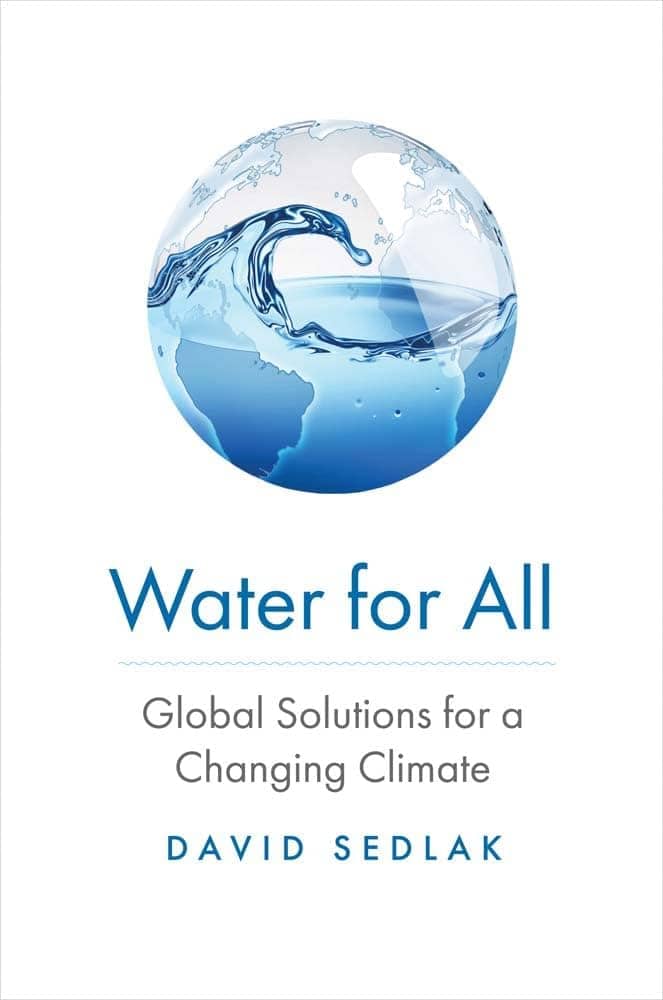
And page 255, there’s this sentence:
“Some epidemiologists have even theorized that communities that obtain their drinking water from sources that are deficient in lithium (as in the case for desalinated water) have higher rates of suicide and violent deaths.”
David Sedlak – Water for Alll
That started to be too much to ignore, so I opened the fridge, took out my notes, added the references David quotes in the book, and went down the rabbit hole: here we go.
A 1989 study from Texas on micro-dosed Lithium
Gerhard Schrauzer was a Professor at the University of California in San Diego when he published the paper that’s actually quoted in all the other ones I read.

In his 1989 study on Lithium in Drinking Water and the Incidences of Crimes, Suicides, and Arrests Related to Drug Addictions, he actually takes advantage of Texas’ quite specific geology, which leads wells used for the public supply of drinking water to sometimes have some of the lowest lithium concentrations in the entire USA, and sometimes some of the highest, at just some kilometers of distance.

Hence, using 10 years of data, from 1978 to 1987, he looked into the statistics for homicide and suicide rates, but also rapes, robberies, thefts, burglaries, assault, motor vehicle thefts, arrests for possession of drugs, and the total crime rate, and mapped those against the lithium content in drinking Water in 27 Texas counties.
Lithium drastically reduces suicide, homicide and rape
The results are spectacular: for all the parameters except assault, the differences between the high, medium and low lithium-in-water counties are statistically significant.
Even when excluding the biggest Texan cities from the comparison, to have somewhat constant psychographics across the counties compared, the differences in incidences of homicide, rape, and suicide were consistently lower by 30 to 50% in high-lithium places. Arrests for hard drug possession were even divided by three.
In a nutshell, there is a strong inverse correlation between crime and suicide rates and lithium concentration in tap water.
But is this correlation an isolated fact in the Texan eighties? Not really.
An Austrian Study on Micro-Dosed Lithium’s Positive Health Effects
Using a similar methodology, Nestor Kapusta, a professor at the Medical University of Vienna looked into 99 Austrian counties, and with his team, he showed that the overall suicide rate as well as the suicide mortality ratio were inversely associated with lithium levels in drinking Water and remained significant after sensitivity analyses and adjustment for socioeconomic factors.

…and the same results again, in Japan
Meanwhile, at yet another end of the World, Hirochika Ohgami, a researcher at the Department of Neuropsychiatry of the Oita University Faculty of Medicine, studied lithium levels in tap water in the 18 municipalities of Japan’s Oita prefecture in relation to the suicide standardized mortality ratio in each city. And he found that the lower the lithium levels, the higher these standardized mortality averages were.

Similar studies were conducted with similar results in Denmark and Greece, but I think you got the point.
The limit of “ecological studies” on lithium in low dose
Yes I know, correlation is not causation. In science, there can be smoke without fire. For instance, beer consumption rises significantly in hot summers because people are thirsty. And in hot summers, the air pollution in cities rises as well, because the air mass is not moving so much. So, when beer consumption rises, air pollution does as well, yet those two have no causation link one to another.
Further studies on Micro-Dosed Lithium’s positive health effects
Yet, without wanting to leverage a Barnum effect on you, I can quote several more studies that look into the positive health effects of low-dose Lithium, such as Marielza Andrade Nunes’ study at the Department of Physiological Sciences of Sao Paulo, which showed a stark impact on the slowing down of Allzheimer’s degenerative aspects under the effect of micro-dosed Lithium they gave over 15 months to sick patients, while Lars Vedel Kessing of the Psychiatric Center of Copenhagen showed like in the previous studies that the incidence rate ratio of dementia was decreased in Denmark’s population that was exposed to more than 15.0 μg/L of Lithium in their tap water.
So let me skip the countless other examples I gathered of studies that looked into the positive effects of micro-dosed Lithium on kidney aging, heart and cardiovascular diseases, osteoporosis, and even cancer – if you’re interested in all of these, have a look at this summary article and its extensive bibliography.
Why do we refuse the Lithium Miracle Pill?
I’ve been checking Google Scholar, Springer Online, and even the excellent Custom GPT developed by Consensus to look for adverse health effects of micro-dosed Lithium, and here’s the thing: there’s little to nothing.
Does that mean that micro-dosed Lithium has no drawbacks? Not by itself. What this absence of result shows is that it’s not investigated.
Why?
Because I guess for long there’s been kind of consensus that this wasn’t needed. Let’s remove the word “micro-dosed” for a minute and do a bit of history to understand.
A quick history of Lithium’s medical claims
If you’re like me, quite a fan of sad and tortured rock or grunge music, you probably know Evanescence’s “Lithium” song or Nirvana’s “Lithium” song.
Coïncidence? I think not! Lithium has been known since the second half of the 19th century to treat a whole range of mental disorders, but in the first place, for wrong reasons.
Lithium’s real health effects were misunderstood
Doctor’s thought that, as Lithium could dissolve uric acid, and as uric acid was believed to be the cause of a whole range of diseases, including depressive and manic disorders, Lithium should be massively used wherever possible.
You know how Coke used to be made of real cocaïne, well, in the age of Coke fountains, it also used to be mixed with Lithia Water. If that didn’t cheer you up enough, you could go for another soda instead:
Bib-Label Lithiated Lemon-Lime Soda. That one took a shorter name in 1936 to take the atomic mass of Lithium – seven – and indicate it was cheering you up – seven up – true story.
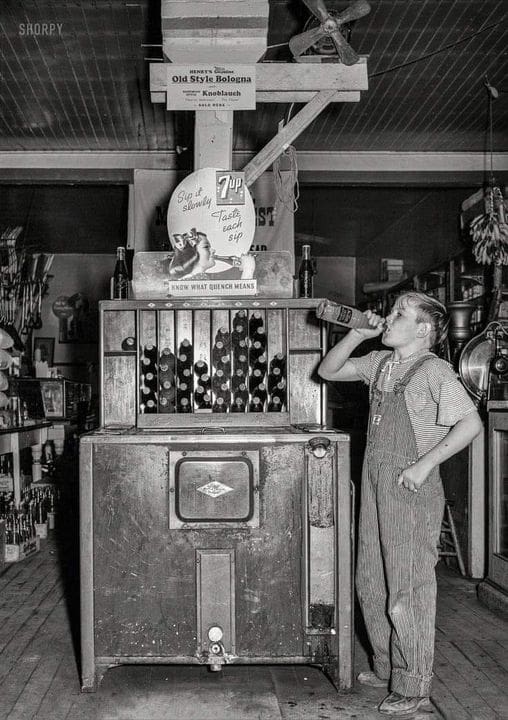
Misused and at High Dose, Lithium is Dangerous
Given the lithium concentrations in those drinks, they were probably harmless, yet something else wasn’t: recommending to cardiac patients to switch table salt – sodium chloride – for lithium salts. It resulted in a wave of adverse effects, with many deaths in that pretty fragile population.
As a consequence by the mid twentieth century, the lithium wave was dead, and Lithium was banned in the US in 1949.
But even if wrongfully understood, the mental health effects of Lithium observed in the 19th century were real. And it grew from medical research in Australia, showing how notably bipolar, schizophrenic, and major depressive disorders could be treated with Lithium Carbonate.
Since the 1970s, that usage of Lithium has been validated, accepted, and recommended everywhere around the World for the most severe mental cases, yet the stigma of the early twenty century’s frenzy remains, and probably explains why micro-dosed Lithium doesn’t get any traction.
Lithium is good to treat mental disorders when nothing else can; now that we know it better, it even comes with fewer adverse effects than it used to, but all the other use cases simply don’t exist on the map, or does it?
The Low Dose Lithium No-Man’s Land
The tab I put in a glass of Water in the beginning isn’t actually the only or even the easiest, or cheapest way to get lithiated Water. There are actually countless mineral waters that have concentrations in the 0.1 to 2 milligram per liter range, like Spain’s Vichy Catalan, Germany’s Gerolsteiner, Italy’s San Pellegrino, US’s Lithia Spring, or even extreme cases like Portugal’s Vidago and its 2.2 miligrams per liter, or the nearly 10 mg per liter found in Slovakia.
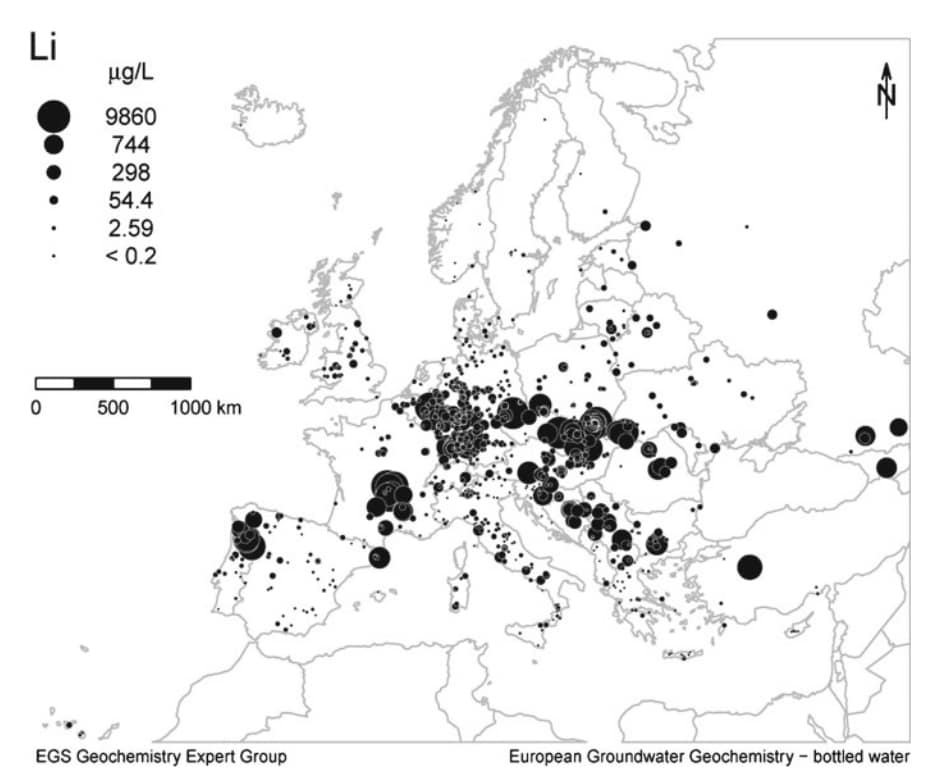
Overall, as you can see on Europe’s map of bottled Water, concentrations in this “micro-dosed lithium” range are quite common and simply the norm if you’re in Northern Portugal, Central France, or South Poland.
Did anyone ever do a study on the adverse effects of Lithium as per its concentrations in bottled Water? Not that I knew or found while researching for this post.
Personal Story: My wife comes from a Lithium-Rich Region
Super short story time: my wife is from the exact center of all these big rounds at the center of France. And she says: “glad water cheers people up there, because aside from that, there’s not much to enlighten your mood.” Her words, not mine, sorry Clermont Ferrand!
What does the Regulation say on Drinking Micro-Dosed Lithium Water?
But seriously, don’t we have norms as to what’s good or not in drinking Water? Potable Water is not a soft science. Usually it’s hard facts, concentrations, and thresholds to meet, so what’s the acceptable limit for Lithium?
Well, none. That’s it, there’s no rule.
The World Health Organization specifically mentions there’s no rule, as – and I quote – “lithium at levels found in drinking water is not considered to pose a significant risk to human health.”
Same for the US EPA: there’s no enforceable legal limit. Some states monitor it, but again, that’s it. Same again in the European Union: nothing.
The closest you’ll find to a regulation is Chile and Argentina, that define environmental limits to Lithium, due to their mining activities in the Lithium Triangle region. But nothing for drinking water.
A consequence of that is that you wouldn’t even know the amount of Lithium in your Water unless someone measured it expressly.
Lithium isn’t even a figure on a bottle’s label
For instance, the San Pellegrino I mentioned earlier, and of which I happen to have a bottle right here, has about 0.2 milligrams per liter of Lithium, which I know because I researched it, but that’s nowhere to be found on the bottle’s label.
In her reference book on minerals and mineral balance in drinking water, Ingegerd Rosborg suggests that “concentrations of approximately 100–200 microgram per Liter are optimal, but as low as 10 microgram per Liter appears to be beneficial.”
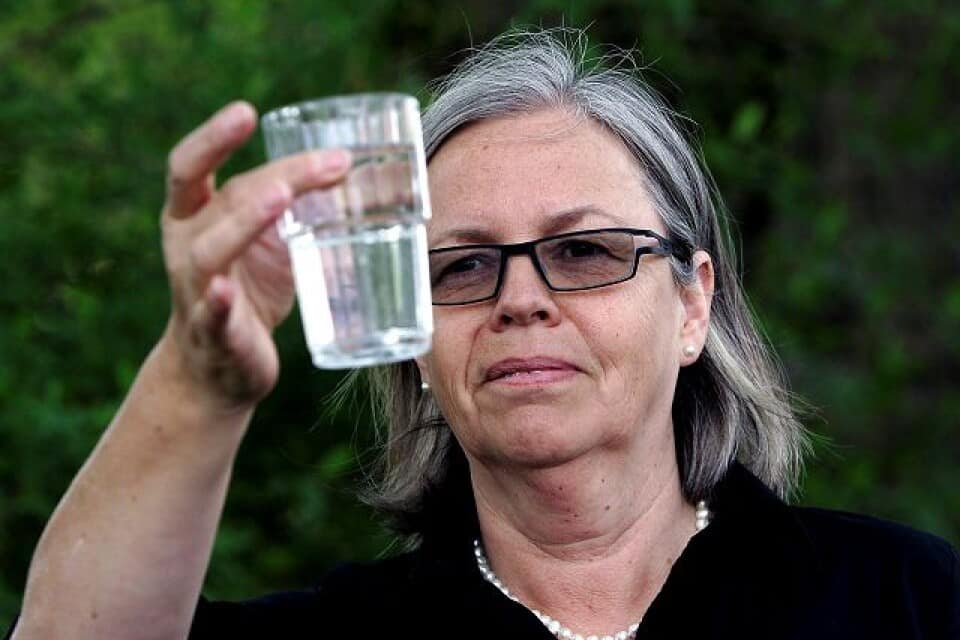
Two Questions moving forward
Let’s quickly summarize what we’ve seen so far. Micro-dosed Lithium appears to have a lot of positive health effects. Even if causation studies in controlled environments might be missing to be 100% affirmative, we can at least say that there’s a body of evidence that tends in that direction. At the same time, nothing at that stage seems to indicate significant adverse health effects.
Micro-dosed Lithium already exists in bottled mineral water, almost under the radar, as nothing would tell so on the bottle’s label. But why would it? After all, Lithium’s not regulated.
That leaves me with two last questions to quickly address. First, could you engage in a lithium-supplement cure if you’d wish?
Again, I’m not a doctor, I’m not debating if you should, I’m asking whether you could.
Legally speaking, of course.
Third Element Water’s offering
Yet, I found out it’s not that easy. If you’re in the US, Sudhir’s Third Element company markets its supplements by box of 20 for 59 dollars. They include more than “just” Lithium, but when it comes to Lithium, there’s 20mg inside, to dilute in 8 fluid ounces of Water.

In normal units – see how I tried to not say non-retarded units, whoops, I said it again – so, in normal units, that’s a quarter of a liter. Sudhir is a doctor, I’m not, but it sounds to me like a higher dosis than the micro-dose we’ve been discussing so far. But assuming you’re drinking your two liters a day, that’s the equivalent of drinking only the high-lithium bottled Water from Slovakia we mentioned earlier.
59 dollars for three weeks is a budget, yet that’s cheaper than bottled mineral water. At least, the option exists.
Micro-dosed lithium is still in its “business infancy”
Because Third Element Water doesn’t ship to Europe, and as a European, when I tried to order from several suppliers I found online, I simply could not get any delivery. Yes, my opening segment was staged; it’s a simple vitamin pill that I used to bubble in my glass.
Is that a business opportunity for some german out there watching this? I don’t know. 😅
Could we supplement Tap Water with micro-dosed Lithium?
Now my second and last question, as I’m a tap water guy. There are places in the World where tap water is fluorinated so it is possible to supplement tap water when the cost-benefit ratio appears positive. And for the 300 million people out there that drink desalinated Water, desalination is always followed by remineralization to meet potable water thresholds.
Yet, as we’ve seen, Lithium is not part of drinking water rules, so no lithium is added to the desalinated water mix, hence the original concern David Sedlak raised in his book.
So, let’s imagine we take the about 100 million cubic meters of Water that are desalinated every day in the World, and mineralize them with the lowest recommended Lithium dose as per Ingegerd Rosborg’s book, 10 micrograms per Liter.
10 micrograms per Liter is one time ten to the minus eleventh power Tones per Liter. And 100 million cubic meters of Water per Day, is one time ten to the eleventh power Liters per Day.
I love when maths are easy: ten to the minus eleventh power times ten to the eleventh power equals one Ton of Lithium per Day.
It would take 5.323 tons of Lithium Carbonate per Day to supplement Lithium in all desalinated water Worldwide
Now, that Lithium would probably be dosed in the most common form, that’s to say Lithium Carbonate. So, we take that ton and we multiply it by 5.323. Again, easy maths, we would need 5.323 tons of Lithium Carbonate every day so that anyone around the globe that’s served with desalinated Water doesn’t get a zero lithium water, but one that seems to have positive health effects.
How much would that cost? Well, at today’s lithium carbonate spot price of 13’500 dollars per ton, we’re talking of 72’000 dollars per day. Or said differently, 0.000007 cents per liter. That’s a zero followed by five zeros and a seven.
I think we could afford that, right?
Micro-Dosed Lithium: My Conclusion
In conclusion, while it seems that the cost-benefit ratio of micro-dosed Lithium in tap water is significantly positive, it also seems like that no man’s land might remain one for as long as nobody cares enough.
In that sense, Lithium is not alone; minerals like Cobalt, Iodide, Rhubidium, Silicon, Vanadium, or, even more surprisingly, Phosphorous don’t exist on the World Health Organization’s map with regard to drinking water.
That alone brought back a memory of what Gerald Pollack told me in the interview I briefly mentioned at the beginning of this video: Water is an under-researched field of science…
Bonus: My Conversation with Sudhir Gadh
These are computer-generated, so expect some typos 🙂
Antoine Walter: Hi Sudhir, welcome to the show. Pleasure Antoine. I’m very curious about what you just exposed to me in a couple of sentences about your company, but for everybody’s benefits, can you do your best elevator pitch?
Sudhir Gadh: My name is Sudhir Gadh. I’m a doctor. I’m a psychiatrist. here in New York. My company is called Third Element Water.
The link there is that we have found a wonderful source of lithiated water in West Texas and bottled it. But instead of just selling that water I’m raising awareness about, not just the quality and the amount of water around the world, but content. The minerals. What are those total dissolved solids? And what is the best solid in there?
It’s actually lithium. The best waters in the world, around the world, in replicated research, hot springs, whether it’s, uh, edipsus in Greece, to Baden Baden, Germany, to Champagne, France, to Osaka, Japan, blue zones and indigo zones. They all have certain amounts of lithium in their water.
Antoine Walter: Specifically lithium? Or lithium and other stuff?
Sudhir Gadh: Absolutely. Lithium and the rest. So it’s a team approach, right? All the rest. Magnesium, calcium, potassium, and an array of, uh, of course, sodium and, and such. So, it’s really this pantheon, I would say, of minerals that makes water more amplifying, is the right word, right? I mean, lithium is a conductor of electricity.
We are electrical beings, and so small amounts actually improve electrical balance immunologically. There have been now effects on my own research, along with the folks in Spain, Galicia Soar, about lithium’s effects on COVID. and post COVID syndrome. So we’re looking at minerals now as, you know, more than just something we take for granted.
What’s the right scale to deploy micro-dosed lithium?
Antoine Walter: Are we speaking of minerals in bottled water, or where, where would you have a chance to bring back that lithium into the water equation?
Sudhir Gadh: We’re looking at it on a spectrum. I research lithium, I research low dose lithium. Not just lithium for bipolar disorder, which is hundreds of times higher. Then what we find naturally, but I research low dose and the wellness nutritional component, which is microdose more or less The way we can include it is to improve awareness that this is not something to be afraid of but rather embrace and so if we look at our water and hope that in demand that it not just be clean and free of lead and copper and bacteria But then we want to take it to another level and make sure why not?
Why can’t we just have not just clean water, but enhanced water the same as in some of the best places in the world where spring water comes from. Let’s recreate that, municipally.
Antoine Walter: Wasn’t it Seven Up? Which had this original recipe with, uh, lithium inside?
Sudhir Gadh: Oui. Uh, the original name was called Bib Label Lithiated Lemon Lime Soda.
And it was called Seven because the atomic mass of lithium is 6. 9. And it made you feel up. So this is not a downer. This is a mood elevator. The latest research in terms of associative research around the world and people who are drinking lithiated water at up to one milligram per liter is that there’s less not just suicide, homicide, crime, Alzheimer’s, psychosis, but there is greater wellness.
Emulating Fluoride’s path to market
Antoine Walter: So you’re raising awareness and you’re showcasing scientific evidence that it is beneficial for People’s health? What’s the next step? How do you elevate the lithium content in a water which doesn’t contain any?
Sudhir Gadh: You can, the way we’ve done with fluoride, the way we’ve done with chloride, you can create a safe recipe of mineral addition.
We’ve done it. It’s available for purchase to put in your glass of water. You have a liter of water and you take our product and put it in there, it will supercharge that water. Like a peel? Like It’s a powder. It’s a small packet of powder. And that’s what we can do on a micro scale. We could do it on a macro scale as well.
And as a result, improve health, because you know that if you have bad water, your health is affected. Growth is stunted. Brain development is stunted. Illness is higher. Rates of living are lower. Lower lifespan. You can actually enhance all of the above with enhanced water, too.
How to navigate the regulation no-man’s land?
Antoine Walter: Potable water is a quite harsh norm.
Depending on the country might be even stricter than others. Some mineral waters, if you were to pass them through that detector, would tell you it’s not possible. It might be good. You can decide to drink the mineral water if you wish, but it couldn’t be distributed at the tap because it’s not potable.
What does your powder, how does it fit with regards to that potable norm? Are you still within the potable norm or would you go above some of the minerals?
Sudhir Gadh: We wouldn’t go above, you know, I think it’s about finding that beautiful mean, that median even, right? Where we know that certain waters, let’s say certain tap, excuse me, bottled waters that I love, right?
Uh, Vichy Catalan, Borgiomi. But those are extreme salty waters. They’re not for everyone. They are supercharged waters, right? As is third element. That’s not what I’m going to recommend we drink in the tap. You’re going to pull that down and find a comfortable middle. But what we have now is on the other end.
We don’t have anything in our waters. We strip the waters. And we put in only chloride and fluoride. But we, we can add proper minerals. And there are deficiencies in this country, in the United States, of vitamin D at staggering rates. Of calcium at remarkable rates. Uh, magnesium deficiencies. Because our terroir is eroded.
We can offset a lot of chronic health issues just at the very basic level of enhancing the water. We enhanced salt. The Chinese figured that out 3, 000 years ago. We enhanced toothpaste and water now with fluoride. We enhanced bread with folate and B12. Save a lot of babies that way. We’re just moving to what’s sensible.
What’s Third Element Water’s Business Plan?
Antoine Walter: What’s your business plan there? Is it B2C? Like you would distribute your powder? As it’s B2B, like you would have utilities to bring back some minerals.
Sudhir Gadh: Yes. So it’s B2B and B2C, right? We want to improve awareness on the consumer and on the grassroots level. And with, with folks like you are so knowledgeable and engineers in this field to give us credibility as well as, you know, a stamp of, yeah, I understand this.
This is not quackery. This is real. And then move into municipal aspects because that’s the. That’s the fear zone. We’re having problems even selling a life saving vaccine to people these days. As a doctor, I understand both sides of this, but we want to enhance health on the consumer side, but also educate individuals and help larger communities.
I’ve done a lot of one on one. I want to do one on many now.
Where does the company stand in its roll out of micro-dosed Lithium?
Antoine Walter: Where are you in terms of deployment or your solution?
Sudhir Gadh: Well, we’re talking with certain municipal communities in the country, having conversations with people. abroad as well. Look at the example of India, where there’s a lot of investment in just leaning up water and then reducing pollution of water.
We can do both. We can say enhance water as well as improve its potability. We don’t have to just stay potable. We can be powerful too.
Some more studies to look up
Antoine Walter: You mentioned your studies on the positive health effects. Is it something you can openly share?
Sudhir Gadh: Of course. If you look up the term low dose lithium, just like you look up low dose vitamin C or high dose vitamin C, that concept did not exist ten years ago in terms of PubMed and searchability.
One of the first people to write papers on that was me, and there are many other great doctors. that are now writing about this and publishing peer reviewed, replicated, global vetted research. The first article is now from Canada, which has a national health system, and it talks about the non psychiatric benefits of low dose lithium in terms of inflammatory health, muscle retention.
GSK3 is an enzyme that ages your brain. We all have it, and it rises. As we age, so our brains get a little harder to be pliable to learn our sleep changes as we age, REM sleep goes down, deep sleep goes down, but lithium in tiny amounts in the right amounts reduces that GSK three enzyme enough to enhance REM sleep.
So you dream more, your brain is cleansed more, you stay younger, top down.
Lithium supplements are not new
Antoine Walter: And so it’s really something which anyone can Dive in and test it. It’s not like something which might be dangerous if it’s too highly dosed or
Sudhir Gadh: you can get low dose lithium over the counter. You can also ask your doctor for it. So there’s no cost barrier.
This is not. A patent. Our formula is a patent. But the concept is, it started the Big Bang. This, this element, it’s everywhere. But I think if you look at it, and if, if you’re convinced by perhaps Pharma or whomever to look at it and see that it’s dangerous, you’re missing the fact that small amounts are actually already in you and in the Earth.
Antoine Walter: I was discussing taste of water some minutes ago with Milind Patel. How does that affect the taste of water? And if it does affect the taste of water, does it affect it positively? Which would be an additional argument, to be honest.
Sudhir Gadh: But, uh, it’s saltier. A little touch saltier. And that can be adjusted, right?
We were going to recognize sodium as a real salt. Lithium is a salt too. But you’re never going to use it in the amount of milligrams that you use sodium. You are never going to sprinkle lithium on a steak, okay? You are going to use tiny amounts, but it’ll make it a tiny bit saltier, a little sharper. It doesn’t really affect the taste.
It’s the whole team of minerals that make water You know, either more creamy or tart or sharp. Patel is is, uh, you know, progressive guys, water, some Somalia and London. We were chatting about this concept and we’re on the same page.
What does the timeline to adoption look like?
Antoine Walter: What’s your outlook? Like if you’re looking into 5 10 years in the future, what’s the impact you want to have?
Sudhir Gadh: I’m going to show that Wherever we have brought this into lives, it has improved lives, and we can measure results. And I’ve done that on the low dose lithium vitamin range, that when we’ve introduced that, we’ve shown the proof of concept in bodies, but we also want to show it in communities. That takes faith, that takes courage for someone to say, you know what, it sounds bold, it sounds crazy, but actually, is it really crazy for a leader, mayor, politician to say, I want to give my people the same water as that they drink in the Dolomites, that they drink in Sardinia, that they drink in northern France.
We just want to create and give you the transparency. These are the mineral contents there. This is what we have. We’re going to improve it. And you can bathe in better water, you can drink that water, you can enjoy it and it will lead to changes in terms of health. I would like to see that happen and prove it the same way that people who live near Vichy de Catalan go there every few weeks.
Antoine Walter: Well, it’s a fascinating field, which I have to confess, I didn’t even know existed. So it’s, it’s interesting. I’d be super happy to look into your, your, your studies. I love to, to, to dig deeper in those topics. So I’m looking forward to discovering even more and maybe we might have a simple conversation after that.
Sudhir Gadh: Thank you. I appreciate you having me on. Thanks.

